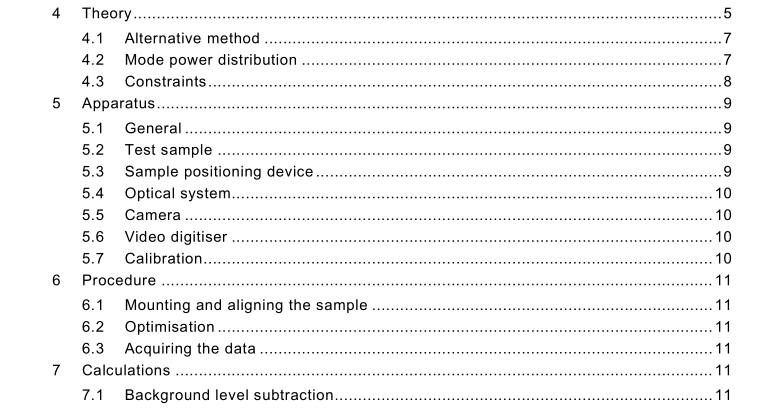IEC 61300-3-43:2009 pdf download – Fibre optic interconnecting devices and passive components – Basic test and measurement procedures – Part 3-43: Examinations and measurements – Mode transfer function measurement for fibre optic sources
5.2 Test sample The test sample consists of a multimode patch cord attached to a light source. It should be recognised that the mode distribution at the output of the patch cord is a product of both the launch conditions of the source and of the patch cord itself. The resultant MTF is therefore not a parameter of either the light source or the patch cord individually but rather of the combination, including the particular conditions under which the patch cord is disposed, such as bend radius.
5.3 Sample positioning device A positioning device is required to ensure that the end of the patch cord under test is located on the optical axis of the instrument and also in the correct axial position to give a well- focussed image on the camera. For this purpose, an XYZ manipulation stage may be used or, preferably, a suitable connector receptacle mounted axially with the optics. An example is a standard 2,5 mm ferrule receptacle which is able to accommodate several connector types,
where
Mag is the system magnification;
NA is the numerical aperture of the fibre.
For example, if Mag = 20, NA = 0,21 , λ = 850 nm then picsize < 24 µm. It is recommended, however, that the camera pixel size is much smaller than this. In this example, the corresponding pixel size at the fibre would be equal to picsize divided by Mag, which is equal to 1 ,2 µm.
5.6 Video digitiser The video digitiser, which is connected to the camera, provides the computer with a digitised image of the fibre end. A typical video digitiser will provide an 8 bit image, although a digitiser providing more bits, for example 1 2, may be used for increased resolution.
5.7 Calibration The calibration factor is expressed in units of µm/pixel. It is required in 7.4 to convert the processed data between pixel space and µm units. The optical system may be calibrated by measuring an artefact of known dimension, such as a microscope graticule or an optical fibre of known cladding diameter. The calibration artefact is positioned in the object plane of the system and focussed onto the camera. In the case of a graticule, illumination may be by transmitted or reflected light. In the case of an optical fibre, reflected light must be used. This is typically achieved by the use of a light source and beam splitter positioned in the optical system between the focussing lens and the camera.
6 Procedure
6.1 Mounting and aligning the sample Mount the fibre to be measured in the sample positioning device in the object plane of the optical system and switch on the end illumination source. Align the lateral position of the fibre end, if necessary, and adjust the focus position of the fibre to give a well-focussed near-field image on the camera. Switch off the end illumination and switch on the source under test, which, if necessary, should be allowed to stabilise.
6.2 Optimisation In order to utilise the full analogue-to-digital converter (ADC) range of the video digitiser effectively adjust the intensity of the image so that it fills typically about 90 % of the ADC range. This may be achieved by any or a combination of the following means:
• adjusting the intensity of the light source;
• the use of neutral density (ND) filters in front of the camera;
• adjusting the gain and/or electronic shuttering of the camera.
6.3 Acquiring the data
A digitised image of the fibre end is then transferred by the controlling computer for analysis. Typically the image is then converted to a two-dimensional array of ADC values for subsequent processing. In order to improve signal-to-noise ratio, several images or frames, can be serially acquired and their ADC values averaged on a pixel-by-pixel basis. A typical number of frames is ten to twenty, although, in the case of a coherent source where agitation must be used to break up the speckle pattern, several hundred frames is typical. If the alternative method (4.1 ) is being used then it is necessary to disconnect the source under test from the patchcord and replace this with a source which overfills the patchcord. A second digitised image is then obtained in the same manner as above.
